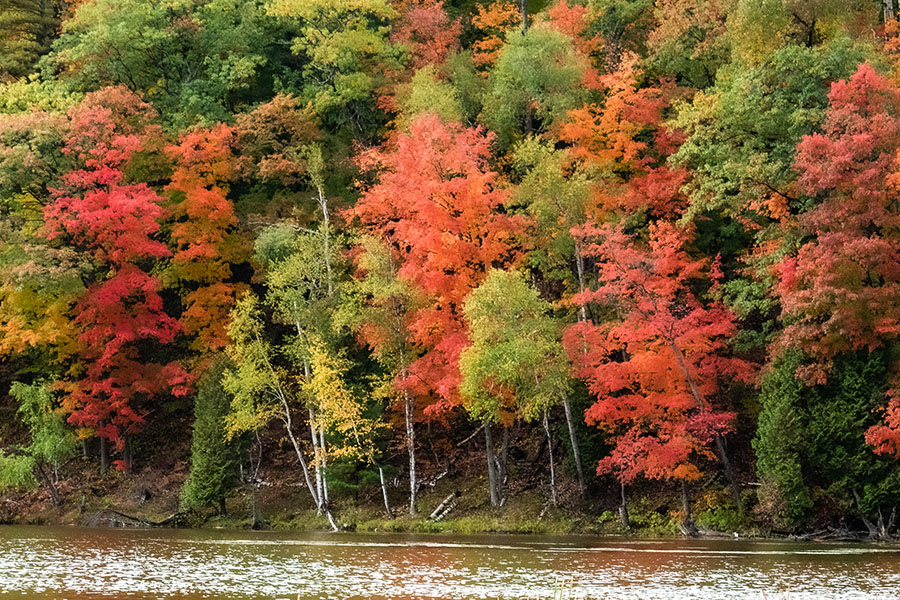By RACHEL COALE, Michigan Department of Natural Resources, Forest Resources Division
The iconic sugar maple is the king of fall, with its glowing yellow-orange hues and wide leaves that flutter in the breeze.
In Michigan, maples often make up 50% of trees planted in urban areas. They’re also common on the natural landscape and include varieties such as red, black, silver, sugar and striped (also called moosewood).
Looking beyond the maple when planting, however, can add a variety of different colors, textures, natural benefits and beauty to your outdoor space.
“In addition to the natural beauty different kinds of trees create, planting a diversity of trees is perhaps the best defense against disease and insect problems that can significantly damage our urban forest,” said Michigan Department of Natural Resources urban forestry program leader Kevin Sayers.
Explore our fall color picks to find a new tree to plant this autumn. Learn how with our tree-planting guide. It covers planting basics from digging the hole to pruning, mulching and watering. Starting off by using the right planting techniques will help your tree grow and thrive.
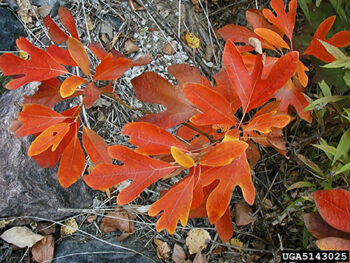
Sassafras (Sassafras albidum)
A spicy scent and a colorful wardrobe of fall foliage ranging from yellow to orange to russet make the sassafras a bold landscaping pick.
Sassafras leaves grow in an unusual, three-lobed shape like a turkey foot, or with two lobes in the shape of a mitten, perfect for a brisk Michigan fall. Some leaves are smooth ovals, with no lobes at all; you may find all three shapes growing on the same tree! They’re so pretty, you might consider pressing sassafras leaves in a book to frame.
The advantages of this shrubby, pyramid-shaped understory tree are that it’s perfectly content in partial-shade locations and won’t grow too tall, topping out around 20-30 feet.
Sassafras is also very tough in cold temperatures, able to survive to a frigid Zone 4, one of the northernmost tree hardiness zones in the U.S. The sweet-and-spicy smell of its leaves and twigs also makes them less attractive to munching mammals like rabbits and deer.
If you needed another reason to plant a sassafras, it’s the host plant for a variety of butterfly species, including the elegant spicebush swallowtail.
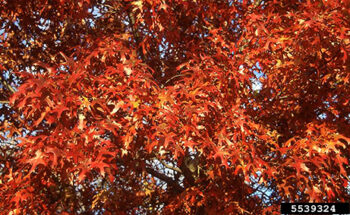
Shumard oak (Quercus shumardii)
We couldn’t put together a fall color list without an oak, known for their majestic stature, long lifespan and oval, lobed leaves.
The Shumard oak is a pick that will extend your fall color season – it remains green long into the fall and then turns a deep orange-red, a standout in a frosty landscape.
This oak tree grows slowly but will eventually become large, rewarding patient planters with lots of summer shade. It’s hardy to Zone 5 and can reach more than 60 feet tall.
Additionally, its acorns will delight visiting squirrels, birds and deer. Oaks are one of the best hosts for bird food, supporting hundreds of species of caterpillars to feed their babies. This strong integration in the food web also makes Shumard oaks a great alternative to invasive trees often planted in landscapes.
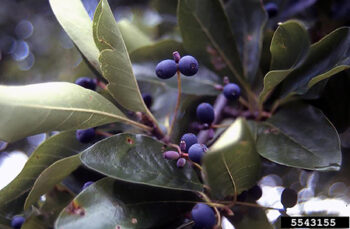
Black tupelo (Nyssa sylvatica)
The black tupelo tree, also called a black gum, swaps its shiny, deep green summer leaves for a stunning coat of scarlet, even edging toward purple, when temperatures drop. This dramatic change could be the root of its Latin name, which translates to “forest nymph.”
This slow-growing, low-maintenance tree tolerates partial shade and wet soils. It features an irregular shape and medium size, growing from 30-50 feet high. It tolerates cold temperatures down to Zone 4. These hardy traits and compact size make it a great replacement for invasive trees.
In addition to providing fantastic fall color, its flowers and berries (which are rarely messy due to their popularity with wildlife) will attract pollinators and birds to your backyard.
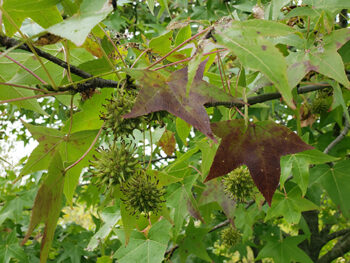
Sweet gum (Liquidambar styraciflua)
Bring star-spangled fall color to your yard in autumn with the star-shaped leaves of the sweet gum tree. Fall weather switches the tree’s glossy, deep green leaves to hues of yellow, purple and red.
Before planting this tree, pick a place where you can avoid the gumballs (not the candy!). The sweet gum tree produces spiky, seed-filled “gumball” fruits that, when dry, are nature’s equivalent of a Lego brick. To avoid undignified yelping and yelling, be sure to plant it somewhere away from walkways or wear shoes when you step out to admire its autumn foliage. If it’s any consolation, finches, sparrows, turkeys and other wild birds will love prying the seeds out of the gumballs.
Sweet gum trees are found wild in Illinois and Ohio and grow well in parts of Michigan. They are hardy to Zone 5 and grow up to 75 feet tall. Give them full sun to be rewarded with splendid summer shade and fast growth.
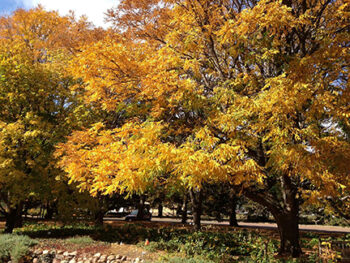
Kentucky coffeetree (Gymnocladus dioicus)
Although it’s said that settlers once made a coffee substitute from the bean-shaped pods of the Kentucky coffeetree, a review by food website “Serious Eats” rated the bitter brew as, well, not great – and potentially toxic if roasted incorrectly!
Perhaps a better way to enjoy a Kentucky coffeetree is to take in its display of golden fall color while sipping a cup of the real deal.
What makes this tree special? It has large, compound leaves that shine with yellow-gold autumn color, tolerates cold down to Zone 3 and grows tall – up to 75 feet. It’s resistant to drought and can tolerate pollution from urban settings. Because of this, it’s widely used as a street tree or landscaping tree in its native northeast and central U.S. range and makes a great look-alike replacement for invasive tree-of-heaven and black locust. A spooky, end-of-fall bonus? Those large leaves fall to leave behind stubby, gnarled-looking twigs that give a haunted house vibe.
Give the Kentucky coffeetree space to grow and full sun for it to thrive.
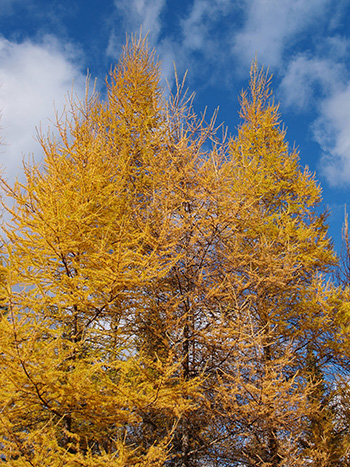
Tamarack (Larix laricina)
Fall color isn’t just the domain of broadleaf trees. Enter the tamarack.
The tamarack is a fascinating conifer tree with soft, green needles in summer and tiny, pinkish cones in early summer. In autumn – surprise! – the needles turn golden and then drop, regrowing in spring. Don’t worry, no raking necessary! At only an inch or so long, the needles will decompose over winter without a mess.
The tamarack is a great pick for areas with wet, clay soil that can be tough for other trees to grow in, though it will tolerate moderate soils with some care. It’s the hardiest of the trees on this list, tolerating a bone-chilling Zone 2.
Plant away!
Once you’ve picked out your tree, it’s time to plant. Using the right techniques will ensure that your tree survives and grows. A few key steps follow.
- Before you start digging, schedule a time to have utility cables and gas lines marked by visiting MissDig.org or calling 811.
- Select your location – make sure your tree will not grow up into power lines and has the right amount of sun to grow.
- Dig a hole that is three times wider than the tree’s container and about as deep.
- Set the tree in the middle of the hole, filling in underneath if needed, to bring the root collar (the place where the roots meet the stem) just above ground level.
- Backfill the hole firmly with soil, creating a sloping basin where water can settle.
- Water the tree well and spread 2 to 4 inches of mulch around the base, leaving space around the trunk. Don’t make the mistake of creating a volcano-shaped mulch pile around the tree’s trunk, which can encourage mold growth and diseases on the bark.
Find hardiness zone information (Michigan mostly ranges from zones 6b-4a), places to buy trees and our interactive tree-planting map atMichigan.gov/MiTrees. Plant your tree, log it on the map and add to the canopy across the state – we’re aiming to plant 50 million trees in Michigan by 2030, and every tree gets us closer.


